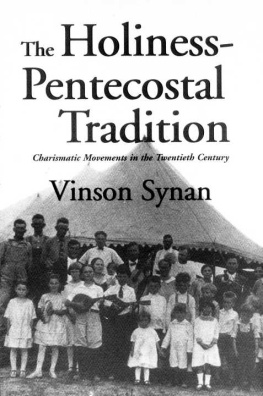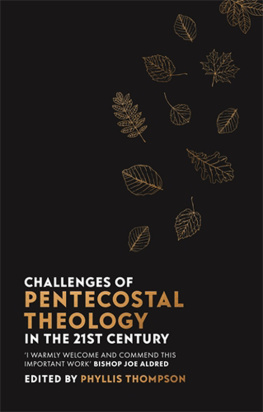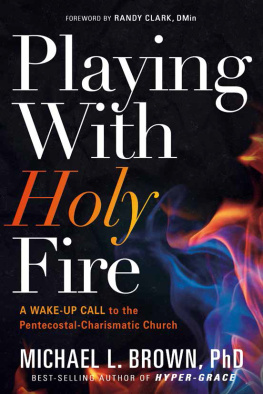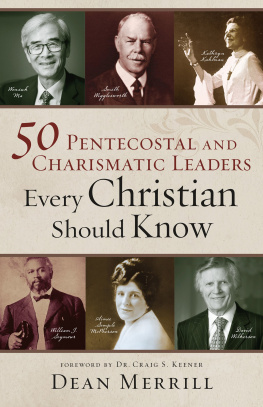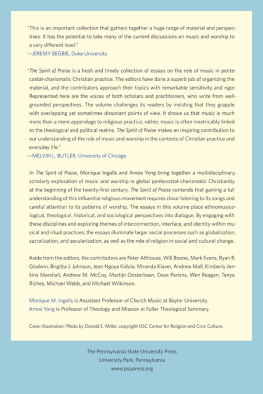Vinson Synan - The Holiness-Pentecostal Tradition: Charismatic Movements in the Twentieth Century
Here you can read online Vinson Synan - The Holiness-Pentecostal Tradition: Charismatic Movements in the Twentieth Century full text of the book (entire story) in english for free. Download pdf and epub, get meaning, cover and reviews about this ebook. year: 2009, genre: Religion. Description of the work, (preface) as well as reviews are available. Best literature library LitArk.com created for fans of good reading and offers a wide selection of genres:
Romance novel
Science fiction
Adventure
Detective
Science
History
Home and family
Prose
Art
Politics
Computer
Non-fiction
Religion
Business
Children
Humor
Choose a favorite category and find really read worthwhile books. Enjoy immersion in the world of imagination, feel the emotions of the characters or learn something new for yourself, make an fascinating discovery.
- Book:The Holiness-Pentecostal Tradition: Charismatic Movements in the Twentieth Century
- Author:
- Genre:
- Year:2009
- Rating:3 / 5
- Favourites:Add to favourites
- Your mark:
- 60
- 1
- 2
- 3
- 4
- 5
The Holiness-Pentecostal Tradition: Charismatic Movements in the Twentieth Century: summary, description and annotation
We offer to read an annotation, description, summary or preface (depends on what the author of the book "The Holiness-Pentecostal Tradition: Charismatic Movements in the Twentieth Century" wrote himself). If you haven't found the necessary information about the book — write in the comments, we will try to find it.
Vinson Synan: author's other books
Who wrote The Holiness-Pentecostal Tradition: Charismatic Movements in the Twentieth Century? Find out the surname, the name of the author of the book and a list of all author's works by series.
The Holiness-Pentecostal Tradition: Charismatic Movements in the Twentieth Century — read online for free the complete book (whole text) full work
Below is the text of the book, divided by pages. System saving the place of the last page read, allows you to conveniently read the book "The Holiness-Pentecostal Tradition: Charismatic Movements in the Twentieth Century" online for free, without having to search again every time where you left off. Put a bookmark, and you can go to the page where you finished reading at any time.
Font size:
Interval:
Bookmark:

TRADITION
Holiness-Pentecostal
Tradition

the Twentieth Century
Vinson Synan
To
Bill Menzies and Horace Ward, gentlemen scholars and colleagues, who joined with me in founding the Society for Pentecostal Studies at the Pentecostal World Conference in Dallas, Texas, in 1970

xi

It has been more than a quarter of a century since this book first appeared under the title The Holiness-Pentecostal Movement in the United States. For more than twenty-four years, after first being published in 1971, it remained in print without revision. At long last I have revised, enlarged, and renamed the book in an attempt to account for the incredible changes that have occurred in the worldwide church since the book first appeared. The new title, The Holiness-Pentecostal Tradition: Charismatic Movements in the Twentieth Century, was chosen with much care. Instead of the word "movement" I have chosen to substitute the word "tradition." This is because I believe that Pentecostalism has grown beyond a mere passing movement to become a major tradition of Christianity. This word is being used despite the fact that most Pentecostals have disdained the word "tradition" as belonging to the older and colder "established" churches, which did not understand the moving power of the Holy Spirit.
In fact, when I did my first research on Pentecostalism around 1965, there were barely 50,000,000 Pentecostals in the world. Now, as this revision appears, that number has grown to encompass some 217,000,000 "denominational Pentecostals" around the globe. Added to this are the millions of "Charismatics" and "Third Wavers" in the mainline churches who were inspired by the Pentecostals. All together, the aggregate number of Pentecostals/charismatic in the world numbered some 463,000,000 in 1995. As the second largest family of Christians in the world after the Roman Catholic Church, the Pentecostal churches can now justifiably be called a major Christian "tradition."
In my earlier book title, I included the phrase "in the United States" since the purpose and scope of the study was to tell the story of the origins of the movement in the nation that gave it birth. The revised edition attempts to cover the story of the spread of Pentecostalism around the world after the heady days of the Azusa Street awakening. Of course, a book of this kind could not possibly cover the origins of the movement in every nation of the world. I have therefore attempted only to describe the beginnings of the movement in several of the nations where it became a major religious force.
The subtitle, Charismatic Movements in the Twentieth Century, points to the various charismatic movements in the mainline churches that had their roots in Pentecostalism. At this point they seem to continue as "movements" in their respective denominations. Whether they become major and lasting traditions remains to be seen.
I also use the word "tradition" for another and possibly more important reason. To me it is clear that the basic premise of Pentecostalism, that one may receive later effusions of the Spirit after initiation/conversion, can be clearly traced in Christian history to the beginnings of the rite of confirmation in the Western churches. This began as an attempt to make practicing, committed, adult Christians out of children who had been baptized as infants several years earlier. It was a very practical and sacramental "second blessing" that conferred the Holy Spirit when the bishop laid hands on the one being confirmed. In ensuing centuries, great doctors and saints of the church created monastic orders for the "religious" who wished to live out a more committed form of Christian life. Many of these spiritual giants, such as St. Benedict, St. Teresa, and St. Francis, laid down "rules" for their followers with "spiritual exercises" that resemble the "blessings" and "deeper experiences" later claimed by the Pentecostals.
In the development of this "second blessing" tradition, one may trace a clear line from the Catholic and Anglican mystical traditions, through John Wesley's second blessing sanctification experience, through the holiness and Keswick movements, to the appearance of modern Pentecostalism. All of these stressed a "deeper" or sometimes "higher" Christian life that went far beyond the level of nominalism that characterized the majority of Christians for most of the history of the church. Although theologians of these various historic streams would profoundly disagree with each other over the timing and content of the "second blessing," they all held tenaciously to the conviction that not all of Christian experience was received at the moment of conversion/initiation.
What made the Pentecostals different from their predecessors was the teaching that the charismata, especially the gift of tongues, was the sign of receiving the subsequent "second blessing." As Kilian McDonnell and George Montague have shown in their landmark book The Rites of Initiation and Baptism in the Holy Spirit Evidence from the First Eight Centuries, the essentials of what Pentecostals call the "baptism in the Holy Spirit" was part of the public liturgy of the churches for at least eight centuries after the day of Pentecost. If this is true, then the Pentecostals may well have rediscovered for the modern church what the New Testament church experienced in the power and gifts of the Holy Spirit.
One of the more controversial aspects of my thesis as stated in The Holiness-Pentecostal Movement(1971) was that Pentecostalism was basically a modified "second blessing" Methodist spirituality that was pioneered by John Wesley and passed down to his followers in the holiness movement, out of which came the modern Pentecostal movement. I believe that the passage of time and the research of many scholars have basically supported this position. In the years since 1971, however, I have gained a deeper understanding of the role of the Keswick "Higher Life" contributions to the development of the Pentecostal tradition.
This book, then, is the story of the rise and development of the Pentecostal tradition from the early days of rejection when they were, in the words of David Barrett, members of the most "harassed, persecuted, suffering, and martyred Christian tradition in recent history," to the days of acceptance and stunning growth at the end of the century. This could well be the major story of Christianity in the twentieth century. If what Peter Wagner says is true, that "in all of human history, no other non-political, non-militaristic, voluntary human movement has grown as rapidly as the Pentecostal-charismatic movement in the last twenty-five years," then Pentecostalism indeed deserves to be seen as a major Christian tradition alongside the Roman Catholic, Orthodox, and Reformation Protestant traditions.
Font size:
Interval:
Bookmark:
Similar books «The Holiness-Pentecostal Tradition: Charismatic Movements in the Twentieth Century»
Look at similar books to The Holiness-Pentecostal Tradition: Charismatic Movements in the Twentieth Century. We have selected literature similar in name and meaning in the hope of providing readers with more options to find new, interesting, not yet read works.
Discussion, reviews of the book The Holiness-Pentecostal Tradition: Charismatic Movements in the Twentieth Century and just readers' own opinions. Leave your comments, write what you think about the work, its meaning or the main characters. Specify what exactly you liked and what you didn't like, and why you think so.

